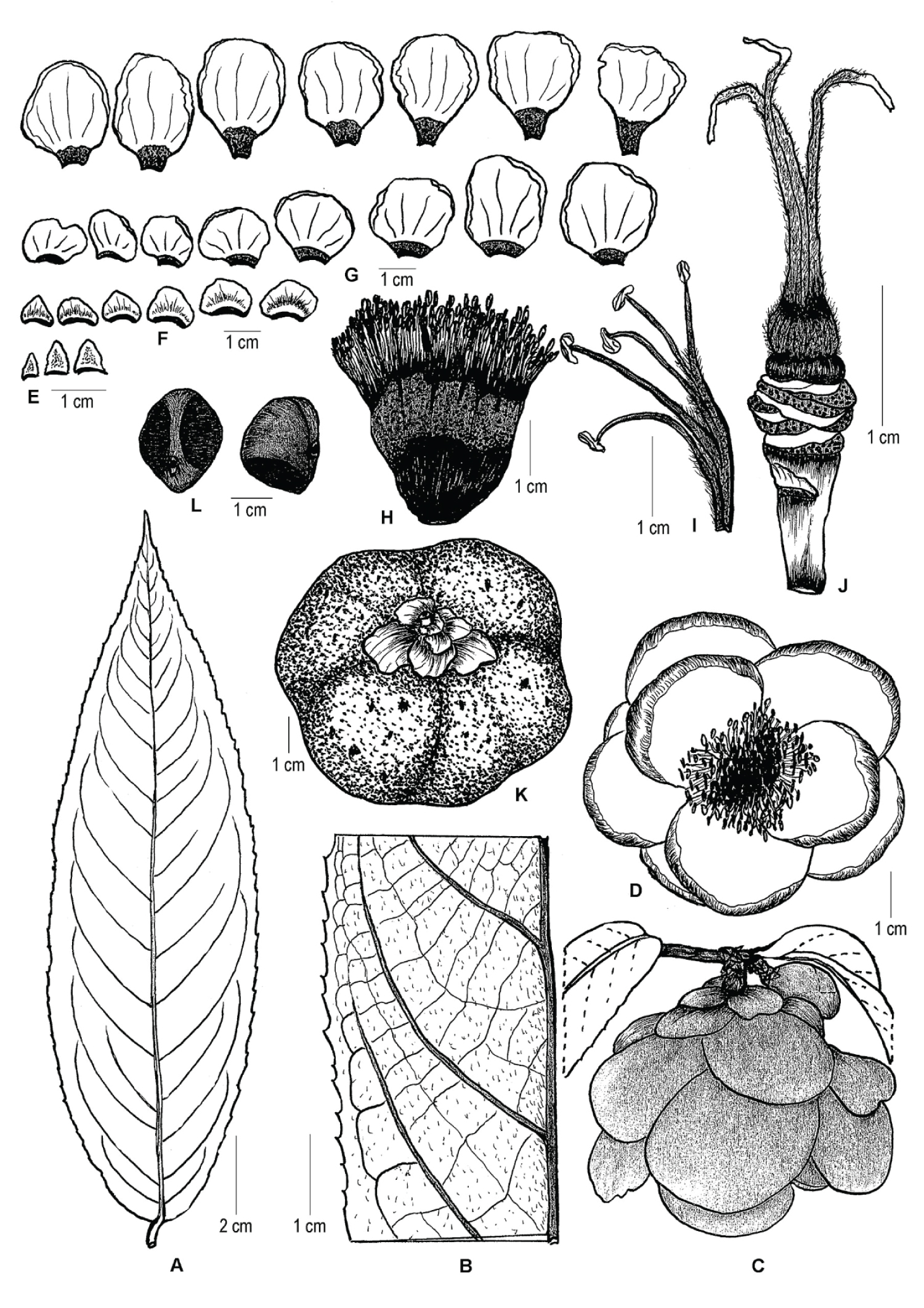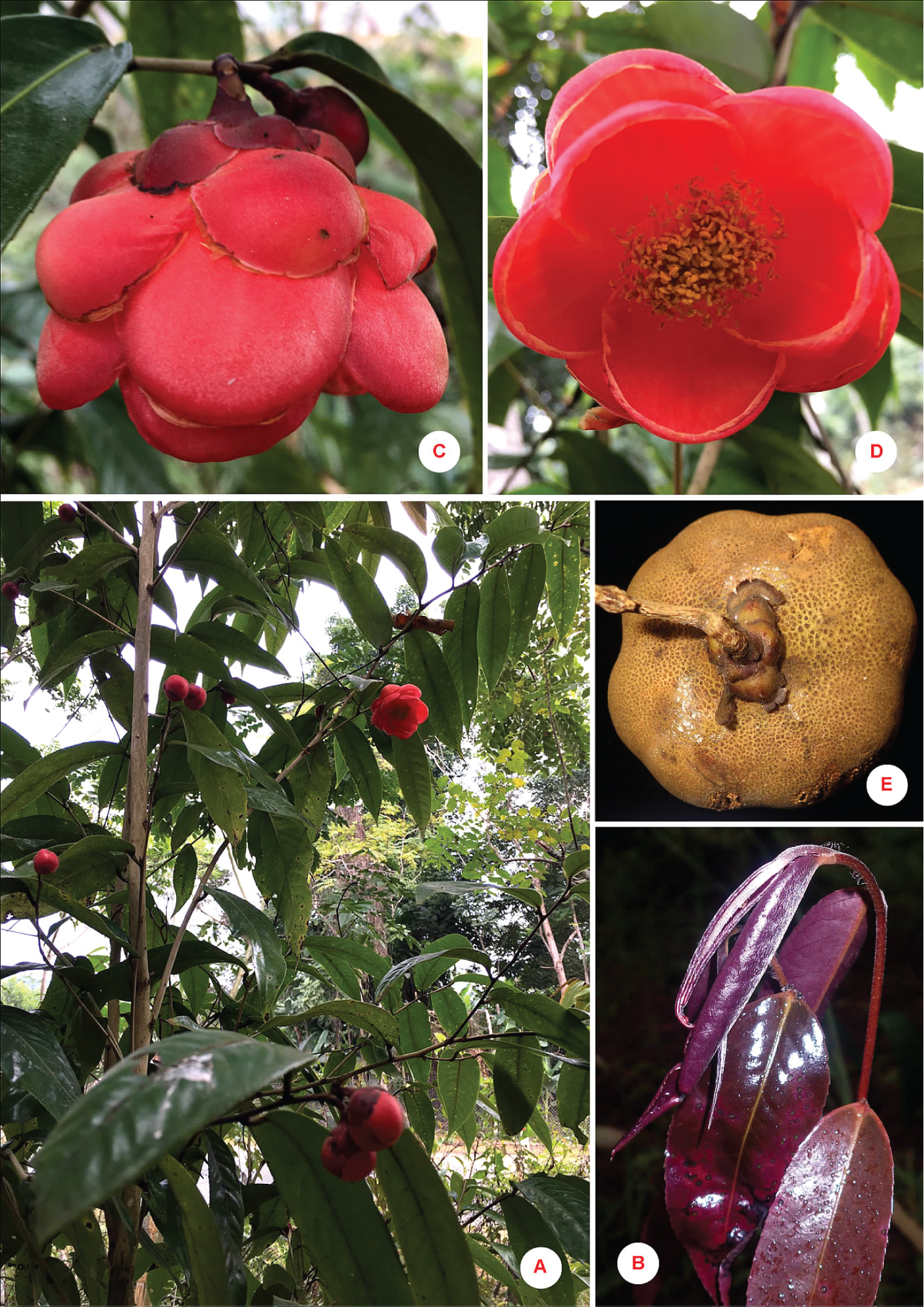Camellia maianhii (Theaceae), A New Species of Red-Flowered Camellia from the North Central Coast Region of Vietnam
Abstract
Camellia maianhii from the North Central Coast Region of Vietnam is described and illustrated. The new Camellia species is tentatively placed in Camellia section Archecamellia (Theaceae). Camellia maianhii is most like Camellia puhoatensis but the morphological characteristics which differentiate it from other species in the section include pendulous pedicels; 5.5-6.5 cm diameter, nodding flowers; 14-15, red petals with both petal surfaces tomentose, and the possession of stout columellae. Information on the distribution, ecology, phenology, conservation status, and the vernacular name of the new taxon are also provided.
Keywords
Archecamellia, Camellia, Columellae, Pedicels, Section, Vietnam
Abbreviations
C.: Camellia; m: metre(s); nov.: new; sect.: section; sp.: species (singular); spp.: species (plural)
Introduction
Currently, 103 species of Camellia L. (Theaceae) are documented from Vietnam [1-4]. The North Central Coast Region of Vietnam includes HaTĩnh, Nghe An, Quang Bình, Quang Trị, Thua Thien Hue, and Thanh Hoa Provinces. Several C. spp. emanate from the North Central Coast Region including Camellia pleurocarpa (Gagnep.) Sealy [5], C. calcicola T L Ming [6,7], C. hatinhensis VD Luong, Ninh & LT Nguyen [8], C. vuquangensis Luong, Tran & LT Nguyen [8], C. pukhangensis ND Do, VD Luong, TS Hoang & TH Lê [9], C. ngheanensis ND Do, VD Luong, NS Lý, TH Lê & DH Nguyén [10], and C. puhoatensis NS Lý, VD Luong, TH Lê, DH Nguyén & ND Do [11].
In January 2016, the field team collected samples of a red-flowered Camellia from XonVillage, Chau Hoi Commune, Quy Chau District, Nghe An Province. The team evaluated the mature plants in-situ, as well as germplasm in the field, and recognized that the plants and specimen material required further investigation.
Regarding Camellia sect. Archecamellia the taxonomies of Sealy [5], Chang & Bartholomew [12] and Ming & Bartholomew (2007) largely agree on the characteristics which circumscribe the sect. The taxonomists of genus Camellia include varying numbers of species in respective of their circumscriptions of sect. Archecamellia i.e., 7 spp. [5]; 3 spp. [12]; 1 sp. [13]; and 18 spp. [14]. Our study primarily used the taxonomic treatment of Sealy (1958), as we believe it to be relatively thorough and well-established. Chang and Bartholomew (1984), a progression from Sealy's treatment, was also consulted especially for species collected since 1958, as well as the sectional treatments of genus Camellia. For additional data Wen [15], Gao, et al., [13] and Ming and Bartholomew [14] were also consulted.
On balance, Despite sharing several features with Camellia sect. Piquetia (Pierre) Sealy thorough analysis of the morphology of the newly collected germplasm tentatively placed C. maianhii in Camellia sect. Archecamellia Sealy as described by Sealy [5]; Chang & Bartholomew [12] and Ming & Bartholomew [14]. The authors affirm this as the new species' flowers are not 'borne on short bracteate shoots in the leaf-axils' Sealy [5] like those of Camellia sect. Piquetia. The species collected from Xon Village, Chau Hoi Commune possesses many of the prescriptive, but not all the characteristics of sect. Archecamellia namely, terminal, solitary, pedicellate flowers; stout pedicels thickened upwards; persistent bracteoles and sepals; corolla red [14]; inner petals basally connate and adnate to filaments; stamens in 5-6 whorls; basally connate outer filaments; styles free; and ovaries 3(-4)-locular. In comparable situations Sealy (1958) considered such species as 'transitional'. We therefore consider C. maianhii to be a transitional species in sect. Archecamellia Sealy [16].
Following a thorough search of the taxonomic literature, electronic and hard-copy herbaria specimens of closely related species it was evident that the Xon Village, Chau Hoi Commune material differed significantly from all known Camellia species, and all published species in sect. Archecamellia and so it is proposed as a new species.
Taxonomic Treatment
Camellia maianhii Curry, VD Luong & ND Do, sp. nov.-Type: Vietnam, Nghe An Province: Quy Chau District, Chau Hoi Commune, Xon Village, 200 m elevation., January 2016, Mai The Anh Mai The Anh, DL160103 (holotype (DLU00008050), isotype DLU!) (Figure 1 and Figure 2).
Additional specimens examined (Paratypes)
Nghe An Province: Quy Chau District, Chau Hanh, Chau Thang Communes, 250 m elevation, June 2021, Mai The Anh, DL210601, DL211201(DLU!)
Diagnosis
Camellia maianhii is tentatively placed in C. sect. Archecamellia Sealy as it possesses several characteristics of that sect., namely terminal, solitary, pedicellate flowers; stout pedicels that are thickened upwards; persistent bracteoles and sepals; a red corolla; inner petals basally connate and adnate to filaments; stamens in 5-6 whorls, free; outer filaments basallyconnate, and 3(-4)-locular ovaries [5,12,14]. The features separating C. maianhii from other species in sect. Archecamellia are its 5.5-6.5 cm diameter flowers; 14-15, red petals with both petal surfaces tomentose; and stout columellae. Camellia maianhii also shares morphological features with C. sect. Piquetia (Pierre) Sealy, including nodding, pedicellate flowers; stout pedicels that are thickened upwards; persistent bracteoles; persistent sepals; 8 or more petals; stamens free above union with petals; and a tomentose gynoecium.
Description
Shrubs, 3-5m tall; twigs white pubescent, purple. Leaves petiolate, oblong-ovate, 13-20 × 4-6 cm, thickly coriaceous, dark green, shiny, glabrous above, paler green, pubescent below, margins shallow serrate; leaf apices acuminate; leaf bases obtuse to nearly round; midribs protruding both sides, lateral veins sunken above, protruding below, 14-19 pairs of veins; petiole falcate, slightly curved, round, 0.7-1.2 cm long, pubescent. Flowers pedicellate, solitary, terminal, nodding, 5.5-6.5 cm in diameter; pedicels 0.9-1.3 cm long, stout, thickened upwards, purple; bracteoles 3(-4), broadly deltate, 4-7 mm long, 2.5-5 mm wide, purple, outer faces pubescent, ciliate, persistent. Sepals 5-6(-7), persistent, sub-orbicularor subglobose, 0.5-1.2 × 0.9-1.5 cm, purple, outer surfaces pubescent, margins membranous and ciliate. Petals 14-15, subglobose to broadly obovate, red, 1.8-5.5 × 2-3.3 cm, both sides tomentose, innermost petals basally united with outermost filaments for 1.5-1.6 cm. Androecium 260-300 stamens in 5-6 whorls, filaments 2.5-3.5 cm long, yellow, pubescent at the base, outer filaments basally united for 2-2.2 cm; anthers 2-2.5 × 1.5-2 mm, light yellow. Gynoecium 3-4-locular, ovaries ovate, ribbed, 6-7 × 4-5 mm, tomentose; styles 3-4, free to the base, 2.2-2.4 cm long, tomentose. Capsules subglobose, 4.8-5.3 high × 6.2-7.1 cm wide, furfuraceous, sparsely pubescent, dehiscing distally into 3-4 parts, pericarps thin, 9-11 mm thick, 1-3 seeds per locule; columellae stout, 2.8-3.2 cm long. Seeds cuneate or semi-globose, 2.1-2.9 × 0.6-0.8 cm, reddish brown, hirsute.
Distribution and Ecology
Camellia maianhii is only known from the type-locality near Xon village, Chau Hoi Commune, Quy Chau District, Nghe An Province. This species grows on moist fertile and sandy soils derived from sandstone parent material on hill slopes and along a stream in secondary evergreen broad-leaved or mixed wood-bamboo forests, elevations of 200-800 m.
Etymology
The specific epithet refers to the name of the discoverer of this species, Mr. Mai The Anh.
Vernacular name (Vietnamese language)
Chèmaianh (Chè = tea; maianh = the name of the discoverer of this species).
Phenology
This species flowers from November to January, and fruits from June to September.
Conservation Status
Camellia maianhii is only known from two populations in the Quy Chau District, Nghe An Province namely, the type-locality near Xon Village, Chau Hoi Commune and the second in Chau Hanh Commune. The area of occupancy is less than 10 km2 and the total population is fewer than 200 mature individuals. Due to the limited known area of occupancy and small population size we consider the IUCN category of Critically Endangered (CR B2ab (iii,v)) to be appropriate for this species [17].
Taxonomic Notes
Camellia maianhii possesses many of the morphological features that characterize species in sect. Archecamellia namely terminal, solitary, and nodding flowers; stout pedicels; persistent bracteoles and sepals; inner petals basally connate and adnate to filaments; stamens in 5-6 whorls; outer filaments united at the base and 3(-4)-locular ovaries [5,12,14]. The three taxonomies currently used for the classification of Camellia sect. Archecamellia comprise a variety of species according to the emphasis the taxonomists place on the possession of specific morphological characteristics. Over the years taxonomists have placed almost fifty species into Camellia sect. Archecamellia sens. lat. The number of species that bear white or yellow-colored petals exceeds forty. When in flower these species are readily separated from C. maianhii by either their white or yellow-colored petals, as C. maianhii produces red petals.
Morphologically Camellia granthamiana Sealy and C. puhoatensis appear close to the new species despite the production of white- or yellow-colored petals by the respective species [5,11]. Other characteristics separating Camellia maianhii from the preceding two species, include leaf size 13-20 × 4-6 cm (Vs. 7-11.5 × 2.7-4.5 cm for C. granthamiana and 17-23 × 5-6.5 cm for C. puhoatensis); greater number of pairs of lateral veins 14-19 (Vs. 6-7 for C. granthamiana and 10-13 for C. puhoatensis); generally longer pedicels 0.9-1.3 cm (Vs. sessile for C. granthamiana and 0.7-1 cm for C. puhoatensis); number of bracteoles and sepals 8-9 (-11) (Vs. 12 or more perules for C. granthamiana and 8-9 for C. puhoatensis); flower diameter 5.5-6.5 cm (Vs. 10-14 cm for C. granthamiana and 4.5-6 cm for C. puhoatensis); petals tomentose on both sides (Vs. trace pubescence abaxially on outer petals for C. granthamiana and petals abaxially pubescent for C. puhoatensis); greater petal number 14-15 (Vs. 8-10 for C. granthamiana and 12-13 for C. puhoatensis); stamens pubescent at base (Vs. glabrous for C. granthamiana and glabrous for C. puhoatensis); locule number 3-4 (vs. 5 for C. granthamiana and 3(-4) for C. puhoatensis); styles 3-4, free ((Vs. 5, connivent at base, apically dividing into 5 recurved arms for C. granthamiana and 3(-4), free for C. puhoatensis); filaments longer than styles (Vs. filaments equal in length to styles for C. granthamiana and filaments longer than styles for C. puhoatensis); ovaries ovate, ribbed and tomentose (Vs. globose-ovoid and tomentose for C. granthamiana and ovoid, with slight longitudinal striations, and pubescent for C. puhoatensis) (Table 1).
The red petal color of Camellia maianhii is dissimilar to most species in sect. Archecamellia, except for C.krempfii (Gagnep.) Sealy, which may be white (Sealy, 1958), or red [12] Despite the uncertainty of the petal colour C. maianhii is distinguished from C. krempfii by its smaller leaves; obtuse to nearly rounded leaf bases; fewer pairs of lateral veins; shorter petioles; shorter pedicels; petals with both sides tomentose; greater number of petals; fewer locules; fewer, longer, and tomentose styles; and ovate, ribbed, and tomentose ovaries (Table 1).
Two other spp. with pinkish-reddish coloured petals are Camellia amplexicaulis (Pit.) Cohen-Stuart sens. lat. and Camellia cattienensis Orel (Sealy, 1958; Orel & Wilson, 2011) [5,16]. The morphological features that differentiate C. Maianhii from these two spp., include leaf size 13-20 × 4-6 cm (Vs. 15.3-16.2 × 6-7.5 cm for C. amplexicaulis and 35-36 × 8.5-9 cm for C. cattienensis); acuminate leaf apices (Vs. obtuse for C. amplexicaulis and acute for C. cattienensis); leaf bases obtuse to nearly round (Vs. auriculate and amplexicaul for C. amplexicaulis and auriculate for C. cattienensis); petioles 0.7-1.2 cm long and pubescent (Vs. 0.3-0.5 cm and glabrous for C. amplexicaulis and 1 cm long and glabrous for C. cattienensis); pedicel length 0.9-1.3 cm (Vs. 1.1-1.2 cm for C. amplexicaulis and 1.1-1.2 cm for C. cattienensis); flower diameter 5.5-6.5 cm (Vs. 4-7 cm for C. amplexicaulis and 5-7 cm for C. cattienensis); both sides of petals tomentose (Vs. brownish velutinous for C. amplexicaulis and not given for C. cattienensis); greater number of petals 14-15 (Vs. 8 for C. amplexicaulis and 8 for C. cattienensis); petal colour red (Vs. pinkish purple for C. amplexicaulis and orange for C. cattienensis); stamens 2.5-3.5 cm long and basally pubescent (Vs. 3.2 cm long, free parts of filaments glabrous and outer filaments united for 2.2 cm form a fleshy cup which is velutinous inside and out for C. amplexicaulis and 4-5 cm long and glabrous for C. cattienensis); locule number 3-4 (Vs. 3 for C. amplexicaulis and 5 for C. cattienensis); styles 3-4, free to base, 2.2-2.4 cm long and tomentose (Vs. 3, free to base, 2-2.1(-2.5) cm long, and glabrous for C. amplexicaulis and 5-parted, basally fused, 3.5-4.5 cm long for C. cattienensis); filaments longer than styles (filaments longer than styles for C. amplexicaulis and filaments equal to or longer than styles for C. cattienensis); and ovate, ribbed and tomentose ovaries (Vs. ovoid, glabrous for C. amplexicaulis and tomentose for C. cattienensis) (Table 1).
Camellia annamensis NS Lý, VD Lương, NĐ Đỗ, TH Lê & TL Nguyén in sect. Piquetia appears like C. maianhii (Ly, et al., 2022). However, the two species are well differentiated by a number morphological differences, namely leaf size 13-20 × 4-6 cm (Vs. 15-20.5 × 5-9 cm for C. annamensis); leaf apices acuminate (Vs. attenuate or narrowly acuminate for C. annamensis); leaf bases obtuse to nearly round (Vs. acute to partially obtuse for C. annamensis); pairs of lateral leaf veins 14-19 (Vs. 10-13 for C. annamensis); flowers not borne on short, bracteate, axillary shoots (flowers borne on short, bracteate, axillary shoots for C. annamensis); petals 14-15, red, with both sides tomentose (Vs. 20-22, bright red with distinct, intense, white margins, velutinous at the tips of abaxial sides for C. annamensis); filaments pubescent at base, longer than styles (Vs. glabrous, styles longer than or equal to filaments for C. annamensis); styles 3-4 (Vs. 4-5 for C. annamensis); ovaries 3-4-locular (Vs. 4-5-locular for C. annamensis); and 1-3 seeds per locule (Vs. 1-2 seeds per locule for C. annamensis).
References
- Hoi QV, Dung LV, Doudkin RV, et al. (2021) Camellia proensis (Theaceae, sect.Piquetia), a new species from Southern Vietnam. Phytotaxa 479: 137-141.
- Hoang TT, Le HE, Nguyen TL (2022) Camellia thuanana (Camellia sect. Chrysantha) - A new species from Central Highlands, Vietnam. DaLat University Journal of Science 12: 18-26.
- Quach VH, Luong VD, Hoang TT, et al. (2022) Camellia quynhii (Theaceae, sect. Stereocarpus), a new yellow species from Central Highlands, Vietnam. DaLat University Journal of Science 12: 3-9.
- Truong QC, Le VH, Le VS, et al. (2022) Camellia sphamii (Theaceae, sect. Piquetia), a new taxon of yellow flower from Langbiang Biosphere Reserve, Vietnam. DaLat University Journal of Science 12: 10-17.
- Sealy JR (1958) A revision of the genus Camellia. Royal Horticultural Society, London.
- Minh TL (1993) Acta Botanica Yunnanica. Kunming 15: 7.
- Le NHN, Luong VD, Nguyen VC, et al. (2020) An updated checklist of Theaceae and a new species of Polyspora from Vietnam. Taiwania 65: 216-227.
- Nguyen LT, Tran N, Chiyomi U, et al. (2018) Two new species of Camellia (Theaceae) from Vietnam. Korean Journal of Plant Taxonomy 48: 115-122.
- Do DN, Luong DV, Nguyen CD, et al. (2019) A new yellow Camellia (Theaceae) from central Vietnam. Korean Journal of Plant Taxonomy 49: 90-95.
- Do ND, Luong VD, Le TH, et al. (2020) Camellia ngheanensis (Sect. Chrysantha: Theaceae, a new species from Central Vietnam. Phytotaxa 452: 209-216.
- Nguyen DH, Luong VD, Le TH, et al. (2020) Camellia puhoatensis (Sect. Archecamellia - Theaceae), A new species from Vietnam. PhytoKeys 153: 1-11.
- Chang HT, Bartholomew B (1984) Camellias. Timber Press. Portland, Oregon.
- Gao J, Parks CR, Du Y (2005) Collected Species of the Genus Camellia An Illustrated Outline. Huayu Nature Book Trade Co. Ltd. Zhejiang Science and Technology Publishing House, Zhejiang.
- Ming TL, Bartholomew B (2007) Theaceae. In: ZY Wu, PH Raven, DY Hong. Flora of China, Hippocastanaceae through Theaceae. Science Press, Beijing and Missouri Botanical Garden Press, St. Louis, MO, USA, 12: 366-478.
- Wen X (2004-onward) Xiangying Wen’s Interactive Keys. South China Botanical Garden and Herbarium, South China Botanical Garden, Leyiju, Guangzhou.
- Orel G, Wilson PG (2011) Camellia cattienensis: A new species of Camellia (sect. Archaecamellia: Theaceae) from Vietnam. Kew Bulletin 66: 565-569.
- Beech E, Barstow M, Rivers M (2017) The Red List of Theaceae. Botanic Gardens Conservation International, Richmond, Surrey, UK.
- Orel G, Curry AS (2017) A Long-term Study 1999-2017 and Taxonomic Review of Camellia amplexicaulis (Pitard) Cohen Stuart sensu lato. Orel & Curry, Sydney, Australia.
Corresponding Author
Anthony S Curry, The aceae Exploration Associates, 3 Ferguson Road, Springwood, NSW, 2777, Australia.
Copyright
© 2023 Nguyen TT, et al. This is an open-access article distributed under the terms of the Creative Commons Attribution License, which permits unrestricted use, distribution, and reproduction in any medium, provided the original author and source are credited.






